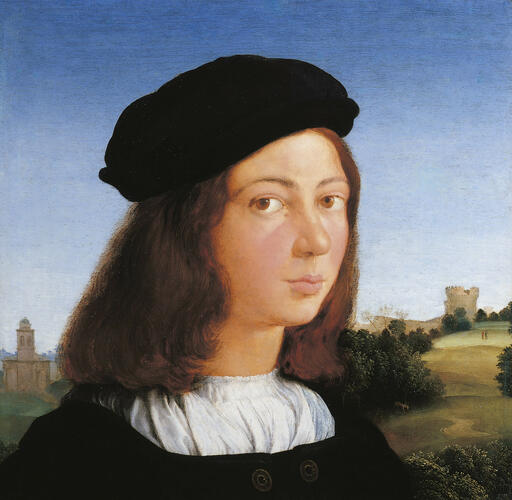Portrait of a Man c. 1506-13
Oil on poplar | 42.8 x 41.9 cm (support, canvas/panel/stretcher external) | RCIN 405760
-
This portrait has been accepted by some art historians as by Raphael painted around 1505-6 in Urbino, and by some as a self-portrait. Others have rejected the attribution and identification, without agreeing if the artist comes from Umbria, Tuscany, Emilia or Romagna. So is this of Raphael and/or is it by Raphael?
If the roughly 20-year-old sitter is meant for Raphael, then the painting must date from between the (possibly self-portrait) drawing c.1500-02 (Ashmolean) and the self-portrait in the Uffizi, Florence of c.1506. However, the young man here has more bulbous eyes and nose and fuller lips than images of Raphael at any age. The inscriptions on the eyelets of the cloak read ‘RAFFAELLO’ and ‘URBINUS’. It is not clear if this inscription refers to the artist or sitter.The combination of Italian and Latin cannot be found in Raphael's own work.
The painting has been cut down at the sides and the bottom. It is likely that originally the sitter’s hands were included and he may have been framed by two columns, perhaps of red marble as in two similar portraits (Alte Pinakothek, Munich and J. Paul Getty Museum, Los Angeles). All three seem to be by different artists and have been associated with Raphael's St George and the Dragon of c. 1506 (National Gallery of Art, Washington). The landscapes in all these paintings show the influence of the Netherlandish artist Hans Memling (compare his St John, Alte Pinakothek, Munich, or St Veronica, National Gallery of Art, Washington). Here Memling influenced details of the background, most noticeably in the stag, fortified towers and minutely rendered foliage.
The two vistas of landscape on either side of the sitter in this portrait are slightly different from each other. This is not unprecedented in Raphael’s work. In this painting the same pigments occur in both areas of landscape, but they seem to come from different periods in the artist’s work.The right-hand side belongs with the works of c.1505, but the passage on the left is more loosely painted, with a distinctive cool blue-green found in paintings by Raphael after he had moved to Rome in 1508. The hot pink tones in the young man’s face and the painterly treatment of his shirt also relate to paintings of this later date, such as the Pope Julius II of 1511 (National Gallery, London).
The crude single-line underdrawing, some visible to the naked eye, is unlike Raphael's drawing style and has the mechanical quality of someone following a tracing. The artist knew Raphael's work well. This can be seen not only in the landscape, but also in details such as the way the eyebrows are painted, the neckline and folds of the shirt. At the same time he was not a mere copyist: adjustments have been made to the composition, most notably the extension of the shirt over the grey (now showing black) on his left shoulder. The portrait may be a pastiche of Raphael, perhaps painted shortly after his death in 1520, when there must have been great demand for works by the master (and likenesses of him). It may, on the other hand, be a copy of a lost original portrait of a man by Raphael dating from c.1507. The portrait seems to have been painted by an accomplished artist with intimate knowledge of Raphael’s early work who brings his sources together to create an intriguing whole.
The painting appears in Pyne's illustarted 'Royal Residences' of 1819, hanging in the Old Dawing Room at Kensington Palace (RCIN 922153).
Catalogue entry adapted from The Art of Italy in the Royal Collection: Renaissance and Baroque, London, 2007Provenance
Presented to George III by the 3rd Earl Cowper, in 1781, as a self-portrait by Raphael
-
Creator(s)
Acquirer(s)
-
Medium and techniques
Oil on poplar
Measurements
42.8 x 41.9 cm (support, canvas/panel/stretcher external)
60.2 x 60.0 x 7.0 cm (frame, external)
Category
Object type(s)
Other number(s)
Alternative title(s)
Self-portrait, previously entitled
Portrait of a young man, previously entitled
A youth in a black cap, previously entitled










